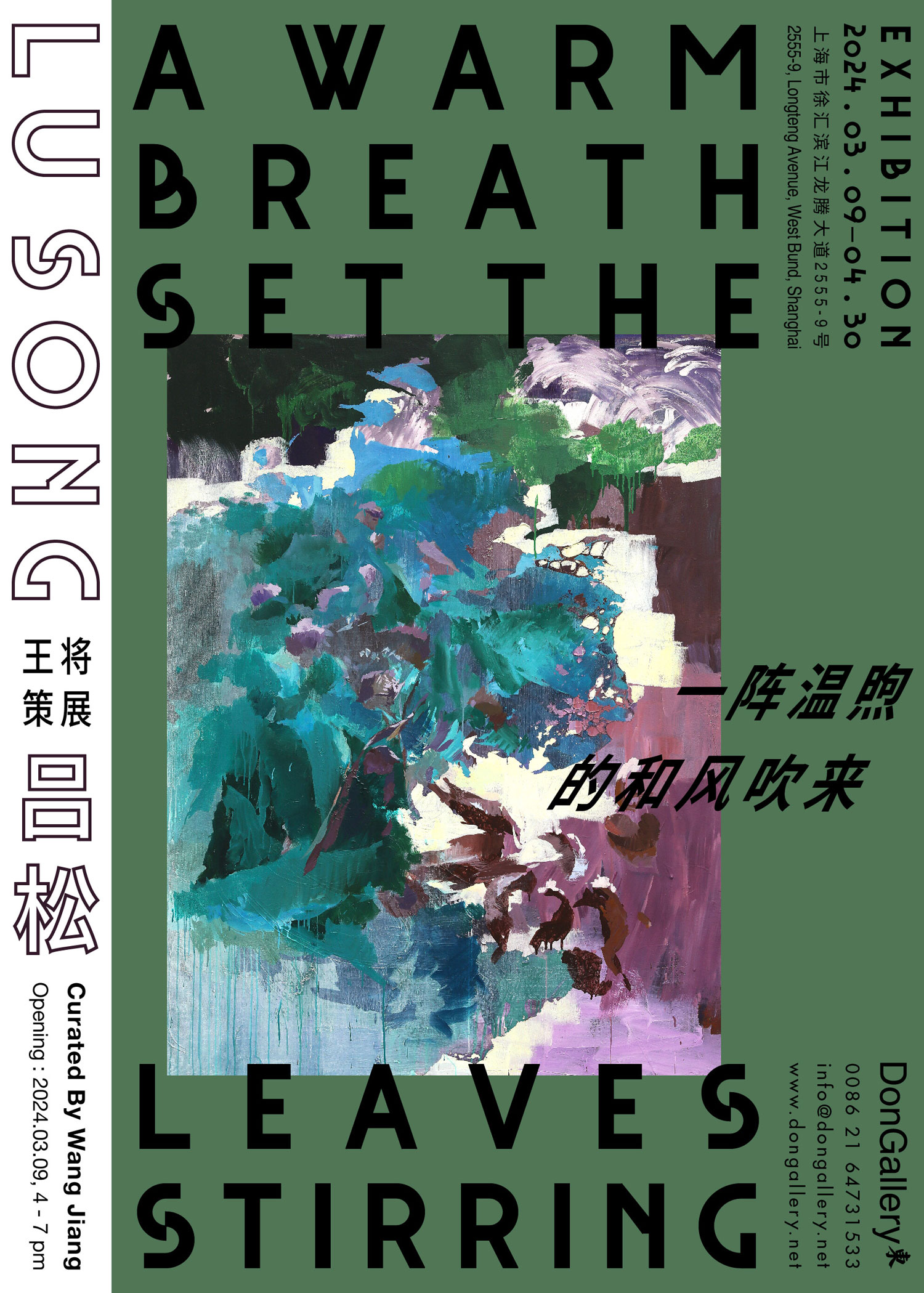展期 Period:
2024.3.9—2024.4.30
艺术家 Artist:
策展人 Curator:
地点 Venue:
新闻稿 Press Release:
东画廊欣然宣布将于2024年3月9日举办艺术家吕松个展《一阵温煦的和风吹来》,将展出吕松近两年来创作的全新作品。展览由王将担纲策展人,展期将持续至2024年4月30日。
一阵温煦的和风吹来,叶簇纷纷颤栗。“绿叶,是树的肺,就是树的肺腑,所以,风是它的呼吸”,鲁滨逊这样想着。他想象他自己的肺,也在体外张开来,紫红色的肉的荆棘丛,活珊瑚的珊瑚骨,还长着绯红色的膜,分泌着黏液的海组体……这一束肉质的鲜花,是这样茂盛,又这样纤细敏感,在半空中不停地摇曳着,绯红色的欢乐从那充满鲜红的血的主干的通道灌注进他的全身……
上文引自米歇尔·图尼埃(Michel Tournier)的小说《礼拜五或太平洋上的灵薄狱》,这部小说重构了丹尼尔·笛福的《鲁滨逊漂流记》中的故事。在其中,这段话不仅描绘了一种自然现象,更象征着主人公鲁滨逊对自我认知和自然界认知的转变。鲁滨逊在孤岛上的生活使他从一个理性主义者转变为一个与自然和谐共存的“元素之人”。作者意图以此探索文明与野性的对立以及人类存在的深层意义。
“一阵温煦的和风吹来”,吕松新展借此为题,不仅呼应了其作品中对自然的描绘和对生命力的颂扬,更表达了他对人与自然关系的探索和思考。而引文的故事背景还喻示了吕松对艺术创作的理解。正如图尼埃小说中鲁滨逊的转变,吕松的创作也体现了他对自我和世界的不断探索和认知。
展览将着重呈现《树舞》和《栗色怀抱》两个系列,其画面展现着自然中生命的力与美,以及它们在人眼中的坚韧和超越。对人来说,与自然的互动,不仅是为了生存,还是为了实现某种超越。这种超越也许是对自然力量的尊重和敬畏,也许是对生命意义的探索和理解。吕松描绘自然,他的画中虽然没有人的形象,但其视角却隐现了人在自然景观中的沉思和感悟。其审美体验超越生存的需要,成为个人精神生活的重要部分,而生存与超越的主题往往又与灵性探索密不可分。
此外,吕松《剧场》系列的焦点从此前的外部合作转向了内部的自我对话。他开始编辑自己在不同时间段中创作的图像,合成碎片化的全新画面。画面没有明确的中心主题或线性叙事,这便提供了多重解读的可能。其绘画方式体现了他对过往创作的反思和整合,他通过深入挖掘绘画的观念性与随机性,并不断精进其技巧,从而把握一种特殊的绘画语言。
在这个充满奇迹和变化的世界中,吕松的绘画向人提示,生命不仅是一场物质的旅程,更是一次精神的探索。正如米歇尔·图尼埃在《礼拜五或太平洋上的灵薄狱》中所写:“真正的发现之旅不是寻找新的景象,而是拥有新的眼睛。”
Don Gallery is pleased to announce LU Song’s solo exhibition, “A Warm Breath Set the Leaves Stirring”, which will open at the gallery on 9 March 2024 and feature a series of brand-new paintings created by the artist over the past two years. The exhibition was curated by WANG Jiang and will run until 30th April 2024.
The leaf clusters swung in the warm, gentle breeze. "The green leaves, which are the lungs of the tree, and so the wind is its breath", Robinson went on to say. He imagined his own lungs being open outside of his body, along with the sea complexes, thorn bushes of purplish-red flesh, coral bones of living coral, and still-growing scarlet membranes and mucus-secreting flowers, as well as the lush, delicate, and sensitive bouquet of fleshy flowers that was ceaselessly waving in midair and the scarlet joys that poured into his body from the main trunks of the channel that was filled with scarlet blood......
The passage above is taken from Friday, or, The Other Island (1967) by Michel Tournier, a novel that reconstructs the Robinson Crusoe narrative as told by Daniel Defoe. The quote not only depicts a natural phenomenon but also symbolises a transition in the protagonist Robinson's perception of the natural world and himself. Robinson transforms from a rationalist to an "elemental man" who lives peacefully with nature as a result of his isolated experiences on the island. The author intends to investigate the deeper meaning of human existence as well as the conflict between civilization and wildness in this way.
The exhibition title "A Warm Breath Set the Leaves Stirring" conveys LU Song’s exploration and contemplation of the interaction between man and nature in addition to echoing his portrayal of nature and celebration of vitality in his works. A further metaphor for LU Song's conception of artistic creation can be found in the background of the narrative that is cited. Similar to Robinson's metamorphosis in Tounier's book, LU Song's inventions reveal his ongoing investigation and understanding of the self and the outside world.
The exhibition will centre on two series, “Dance of Trees” and “Marron Hugger”, whose pictures capture the strength and beauty of life as it exists in the natural world, as well as how resilient and transcendent it is in the eyes of humans. Humans need to engage with nature not just to survive, but also to reach a higher state of consciousness. This transcendence could be the discovery and comprehension of life's purpose or the awe and respect for the force of nature. LU Song paints nature, and while he does not include any human figures in his works, his viewpoint conceals how a man would think and see the natural world. The ideas of transcendence and survival are frequently intricately interwoven into spiritual inquiry, and his aesthetic experience transcends the necessity for survival and becomes a significant aspect of one's spiritual life.
Furthermore, LU Song’s Theatre series has turned its attention from external partnerships in the past to self-talk conducted inside. He started altering his own photos that he had taken at various points in life to create new, fractured images. There is room for interpretation because the photos lack a distinct main topic or coherent storyline. His painting style is a reflection of his reflection and integration of his earlier works. He has developed a unique painting language by exploring the philosophical and arbitrary aspects of painting and by constantly refining his methods.
LU Song’s paintings imply that life is both a physical and a spiritual journey in a world of wonder and change. As Michel Tournier stated in Friday, or, The Other Island, "The true journey of discovery is not to look for new sights, but to have new eyes."

